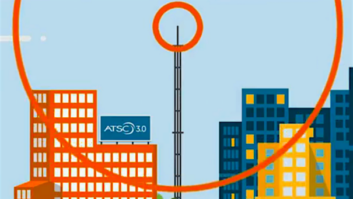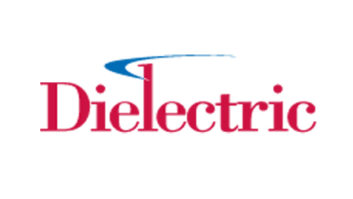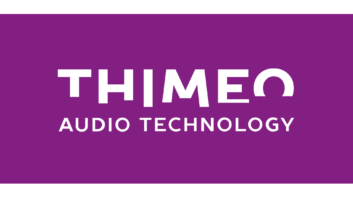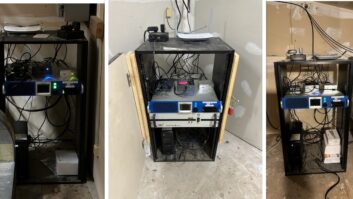WYSO 91.3 FM Turns Relocation Adversity into Opportunity
Dec 1, 2012 7:30 AM, By Jim Stitt
From its humble beginnings in 1958 as a 10W station located in the student union of Antioch College in Yellow Springs, OH, WYSO 91.3 FM has evolved to become the 50kW NPR flagship station and pre-eminent source of public radio in the Dayton/Springfield, OH, market serving more than 1.1 million people. There were many challenges and hurdles along the way, but station personnel persevered to the benefit of the Miami Valley’s public radio audience.

Air Studio
WYSO’s most recent accomplishment culminated this year with the relocation of its studios and offices, forced by the sale of the building in which the station was located. After learning of the inevitable loss of the station’s space, J. M. Stitt & Associates was retained to manage the project and to design and install the facility. Under the stewardship of General Manager Neenah Ellis, and with essential support from the Antioch University administration and board, we were able to turn this potential adversity into a great opportunity for a much needed facilities upgrade.

The project began by identifying the station’s current and anticipated requirements with input from all staff. WYSO’s format is a combination of news, information, and an eclectic blend of music from diverse sources that include NPR, Public Radio International, BBC and our own staff. Much of the programming is locally produced, which places unique demands on the WYSO studio facilities when compared to many commercial stations.
– continued on page 2
WYSO 91.3 FM Turns Relocation Adversity into Opportunity
Dec 1, 2012 7:30 AM, By Jim Stitt
Location, location…
The next step was a search for potential sites and buildings that could serve as a suitable new home for WYSO, along with preparing budgets for each scenario. After extensive research, planning, and numerous reviews, the Antioch University Board approved the funds for WYSO to relocate into the former Kettering Laboratories building in Yellow Springs, OH, which was owned by the University. Supplemental funds for equipment were supplied by a grant from the Public Telecommunications Facilities Program.

Performance interview studio
Locating broadcast studios in a multi-story 60-year-old building originally designed as a research laboratory, and for which there were no plans or drawings, was especially challenging. Locations of existing load bearing walls, columns, and beams had to be considered, as well as integrating new and existing electrical and mechanical systems. Demolishing the laboratory infrastructure and mitigating unexpected hazardous materials added to the complexity and cost. We selected Miller Valentine Group as the contractor based on its experience with building other broadcast facilities, as well as its flexibility in dealing with our unique challenges.
The area designated for the studio suite had no suitable existing HVAC system, and there wasn’t sufficient space for the large ductwork associated with a conventional system. The solution was a Mitsubishi City Multi system utilizing efficient heat pumps. Each studio has its own dedicated fan coil unit, which permits individual control of each room’s temperature. The short duct runs are designed for high-volume, low-velocity air and incorporate noise-attenuating techniques that yield a noise criteria of only NC-20.

Production studio
The new studio electrical service is conditioned for surge and EMI/RFI protection. A diesel generator supplies backup emergency power for all studio and other critical systems. An extensive common point ground system connects the building, STL tower, and ac service grounds via low impedance paths. Each studio has a reference ground connection, and every ac circuit utilizes an isolated ground outlet with its own home run ground connection. The ESD computer carpet and tile flooring are also connected to this ground system.
Lighting in the studios includes incandescent track lights and special wall illumination fluorescent fixtures on dimmers with EMI filtering and remote ballasts. Task lighting in the other operations areas uses fixtures with parabolic lenses and incorporates two different color temperature bulbs on separate switches, allowing the creative staff to alter the lighting to suit their mood.
– continued on page 3
WYSO 91.3 FM Turns Relocation Adversity into Opportunity
Dec 1, 2012 7:30 AM, By Jim Stitt
Set the plans in motion
The resulting floor plan located the entire station on the 14,000-square-foot first floor with adequate expansion space. The administrative offices are in one area and the operations functions are adjacent to the studio suite, but with multiple traffic routes so as not to segregate the two areas completely. The former offices and studios were located on the basement level, so one goal was to incorporate as much natural light as possible.
The 4,400-square-foot studio suite includes the air, production, and performance studios, three edit booths, newsroom, technical operations center, operations and engineering. Custom studio furniture from the Harris Pacific Design Center was incorporated throughout for optimum functionality, and at a cost no higher than using a local cabinet maker. PR&E NetWave consoles are utilized in each studio, all edit booths, and the newsroom with a VistaMax routing switcher networking everything together.

TOC
The technical operations center (TOC) is the station’s central hub. The facility is wired with both Gepco multi-pair AES audio cable and an extensive network of CAT-5 and CAT-6 cabling. Eight Middle Atlantic equipment racks, each with its own UPS, contain the station’s terminal equipment.
The TOC is home to the VistaMax Envoy routing switcher, with all analog and AES digital inputs and outputs on ADC patchbays in the event of a failure. The Envoy cards perform the necessary conversions so that any type source (analog or digital) is available in either format at the outputs. The Envoy HUB also networks all the consoles in the facility so that any source is available in any studio.
The Enco DAD 3TB servers and workstations also live in TOC, with NTI KVM extenders to each studio so there is no fan noise. USB extenders are also utilized so that producers do not have to walk to the TOC in order to ingest a file into a workstation. There is a Gateway workstation setup to scan and remove any viruses from USB thumb drives before files are uploaded into the automation system.
– continued on page 4
WYSO 91.3 FM Turns Relocation Adversity into Opportunity
Dec 1, 2012 7:30 AM, By Jim Stitt
Satellite receivers for 14+ channels and the eTech Ohio network feeds are all distributed and routed in the TOC, as well as other sources such as the Tieline G3 codecs providing VoIP, ISDN, and POTS feeds. Other systems in the TOC include the webcast workstations and processing, Omnia and Optimod on-air audio processing, confidence monitoring, IBOC HD Importer and Exporter, the MCR master clock and its distribution, Moseley Starlink and LanLink STLs, house PA system, ATI and Symmetrix distribution amplifiers, and network printers for the Sage Endec EAS and Burk remote control logs.
In the details
Great attention was paid to sound isolation and room acoustics in the studios. Walls and ceilings incorporate non-parallel surfaces to minimize flutter echoes and were constructed using multiple layer gypsum board, Armstrong Soundsoak and insulation mounted on Kinetics Isomax strips, and suspension hangars to achieve an STC of 55. All joints were sealed air-tight. The IAC studio doors have double magnetic seals and a clever cam lift hinge system to create a threshold drop seal.

Edit studio C
The custom IAC exterior Vision Wall windows and interior Soundlock windows incorporate tilted panes of different thicknesses of glass to prevent sympathetic vibrations from being transferred. Acoustic design also considered the amount of absorption, refraction and diffusion to achieve optimum reverb times.
The air studio/control room and production studio, each 300 square feet, are mirror images of each other so the staff will be more comfortable with a consistent configuration. The Harris custom furniture accommodates an announcer/host and two to three guests, 24-channel NetWave consoles, equipment pods, and a number of unique features requested by the staff. For example, WYSO still uses program material from vinyl LPs during some programs, so turntables with proper anti-vibration bases were required.
Other source equipment includes Denon DN-C635 CD players and Tascam SS-CDR200 decks for recording or playing back from USB drives and other digital media. A Telos NX-12 hybrid system handles the studio phones for call-in shows and interfaces well with the Avaya VoIP system. LCD monitors are supported on Yellowtec Mika arms to allow use of a copy stand while still providing line-of-sight into the performance studio.
– continued on page 5
WYSO 91.3 FM Turns Relocation Adversity into Opportunity
Dec 1, 2012 7:30 AM, By Jim Stitt
The air and prod studios share a common 700-square-foot performance studio space used for recording and/or live broadcasts of musicians and programs with large groups. The room is designed to accommodate variable acoustic panels depending on the application.
A custom mobile interview table from Harris Pacific Design Center can be wheeled into place for a large interview or talk show, or wheeled out of the studio for a band. Custom interface panels provide connections for microphones, direct boxes, monitoring, IT, video, and Telos Nx-12 Desktop Director and call screener.
Three edit booths each accommodate an announcer/host and one or two guests. Each is equipped with a 16-channel NetWave console, Enco DAD workstation, Telos hybrids, CD recorders and other studio equipment. The newsroom has three producers’ cubicles for collecting and editing stories from AP, state and local sources; and will soon have a PR&E Oasis audio console to complement its Enco DAD workstation. The music library contains more than 30,000 CDs and an archive of rare programs recorded on magnetic tape media.
Any broadcast facility designed for the future must include extensive IT facilities. The station’s IT system was dramatically improved with a redundant fiber backbone and 1GB smart switches provided by the University. Our ISP is OARNet and we also have a fiber connection to MVECA. Secure VPN connections allow staff to access the Enco automation, transmitter, and other systems. Encrypted Wi-fi service is available to staff with the proper codes, plus an open Wi-fi service is available to guests with limited access. The IT network supports our studio functions, office functions and our Allegiance software. The Avaya VoIP phone system interfaced well with the Telos NX-12 system and other studio functions.
Relocating the station was done in phases since equipment funding would allow partially equipping only two studios, and some essential systems such as the STL and satellite terminal. The remainder of the equipment would come from the existing station after signing on at the new studios.
Following construction, the plan was to install and make operational a basic facility that would run in parallel with the existing station as a test. We initially built the TOC, air studio, one edit booth, STL, satellite terminal and a portion of the Enco DAD automation. The Enco systems at both locations were synced together over the IT network so that any changes made at one site would also be performed at the other. We then operated both facilities in parallel for a period to ensure proper operation.
The other studios were pre-wired as much as possible to minimize relocation time. The result was a smooth transition that was seamless to both the audience and staff.
After 50 years, WYSO finally has the state-of-the-art facilities and tools required to realize its full potential of producing the very best public radio programming for the Dayton/Springfield market and surrounding communities. The next 50 years will certainly contain more challenges for WYSO, as well as broadcasters everywhere. It is said that tribulation begets perseverance; perseverance develops character, and with character comes hope. WYSO has proven it can persevere and has the character to prevail and succeed.
Layout plan of the WYSO edit booths
Equipment List
ADC ProPatch AES and Bantam Jackfields
Air Tools 6100
Alesis 12R
ATI 2x12XLR AES
Balsys Global Distribution Portal
Broadcast Tools SRC-16
Burk ARC-16 remote control
Cisco managed Ethernet switches
Crown monitor amps
Day Sequerra M4.2R
Denon DN-C635
Enco DAD32
EV RE-20, RE-27N/D
Gepco cable
Harris 3×6 headphone amps, HDE-100, Exporter, HDI-200 Importer, Pacific, Design Center custom furniture, PR&E, Netwave, PR&E Vistamax Envoy, Intraplex STL HD Plus
Henry Matchbox
HP managed Ethernet switches
IAC studio doors
JBL 6332, 4410, Control 5
Marantz PMD-660
Master Clock MCR1000
Middle Atlantic 44Rux36, LCD monitor
Moseley 9003Q-2SLAN, HS900D LanLink
Nautel Exporter Plus
NTI CAT-5 KVW extenders
O.C. White mic booms
Omnia 6exi FM/HD
Orban Optimod 8500 FM/HD
Sage Digital Endec
Samson monitor amps
Sony MDS E11
Startech KVM switches
Symetrix 304, 528E, 581E
Tascam 112B, SS-CDR200
Technics SP-10, SP-25
Telos 1×6, Desktop Director, NX-12
Tieline G3 Commander, Record-IT
Wohler AMP1-V2DA
Yamaha 2000
Yellowtec Mika
Stitt is president of JMS & Associates, Inc., Cincinnati. www.jmstittassociates.com
December 2012
WYSO rebuilds while facing challenges, test and measurement gadgets for your workshop, on-air condenser mics, social media software and Field Reports from Tascam and NewTek….
Field Report: Nautel NV40
WYSO at Antioch University in Yellow Springs, OH, continues to grow to meet the needs of its public radio audience. A new transmitter site is one of its recent projects….
Dayton’s voice of the arts gets a clearer voice
The genesis of this project was an opportunity to relocate and upgrade WDPR’s transmitter site from a deteriorating leased tower that was only 200-feet tall, to the local PBS affiliate’s 1,500-foot tower….












